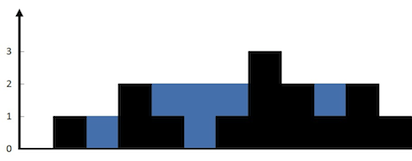Given n non-negative integers representing an elevation map where the width of each bar is 1, compute how much water it is able to trap after raining.
For example,
Given [0,1,0,2,1,0,1,3,2,1,2,1], return 6.
思路:模拟算法,对于每个it,向右查找,分两种情况:
1、右边找到一个不比他矮的,那就把它作为右边界,因为再向右产生的水坑就和it没关系了
2、找不到不必it矮的,就找一个其中最高的且第一次出现的,作为右边界。
然后计算右边界和it之间产生的水坑的面积
//13 ms
class Solution {
public:
int trap(vector<int>& height)
{
int len = height.size();
int res = 0;
int it = 0, max_index = 0, mmax = 0;
while(it < len)
{
max_index = it;
mmax = 0;
for(int i=it+1;i<len;i++)
{
if(height[i] >= height[it])//比他高了,后面的水坑不由it决定了
{
max_index = i; break;
}
if(height[i] > mmax)//找到后面第一个最高的那个,比如50202,就是第三个
{
mmax = height[i];
max_index = i;
}
}
int delta = min(height[it],height[max_index]);
for(int j=it;j<max_index;j++)
{
if(height[j] < delta)
res += (delta-height[j]);
}
if(max_index == it)
it++;
else
it = max_index;
}
return res;
}
};另一个思路,solution中提供的O(n)算法,实际运行时效果反而不是很理想,16 ms
class Solution {
public:
int trap(vector<int>& height)
{
int n = height.size();
int left=0; int right=n-1;
int res=0;
int maxleft=0, maxright=0;
while(left<=right)
{
if(height[left]<=height[right])
{
if(height[left]>=maxleft)
maxleft=height[left];
else
res+=maxleft-height[left];
left++;
}
else
{
if(height[right]>=maxright)
maxright= height[right];
else
res+=maxright-height[right];
right--;
}
}
return res;
}
};






















 283
283

 被折叠的 条评论
为什么被折叠?
被折叠的 条评论
为什么被折叠?








